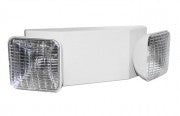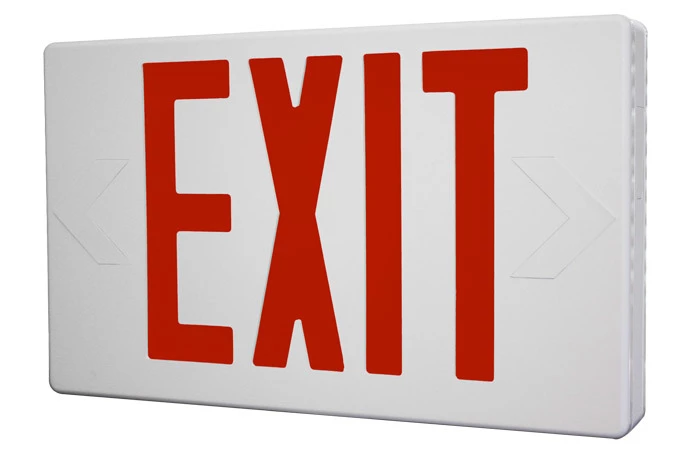Underwriters Laboratories (UL) is a world renowned independent product safety certification organization. UL was established in 1894 and the company is headquartered in Northbrook, IL. Underwriters Laboratories creates standards and testing procedures for all types of products, components, assemblies, tools, and materials, in regards to product safety.
UL is approved by the U.S. Government's Occupational Safety and Health Administration (OSHA) to carry out testing of products and issue certifications. The testing facilities used by UL are inspected and regulated by OSHA.
UL 924 is UL's Standard for Safety of Emergency Lighting and Power Equipment. UL tests and certifies exit signs, emergency lights, and combo emergency exit signs to meet functionality, reliability, and visibility standards.
VIEW OUR UL LISTED EXIT SIGNS:

UL 924 Listed photoluminescent exit signs are acceptable to use in place of UL Listed electrical exit signs.
UL 924 listed electrical exit signs are tested and given a visibility rating of at least 100 feet, meaning in total darkness they are legible from a 100 foot viewing distance. The battery backup systems inside exit signs, which power illumination during power outages, are tested by UL and must provide at least 90 minutes emergency operation. Letters must be red or green and at least 6" height with a 3/4" letter stroke.
Are the lights you buy UL Listed?
As you shop around online for emergency lights and exit signs, you might notice that certain products are proudly advertised as either UL Listed or meets all UL 924 guidelines. This is not merely filler content being added to spruce up the product and sound technical. To be a UL Emergency Light is to meet or exceed the high standards set forth by the Underwriter's Laboratories (UL), the most trusted not-for-profit testing and compliance agency in North America. The UL 924 standards for Emergency Lighting & Controls brings together several other codes and documents including:
- NFPA 101: Life Safety Code
- NEC 700 & 701
- International Building Code (IBC)
- International Fire Code (IFC)
Will Deane, owner and co-founder of the Emergency Lights Company, is a board member of the UL 924 Standards Technical Panel (STP). This panel is like the United Nations of lighting codes, with a diverse membership comprised of representatives from manufacturers, electrical contractors, architects, fire departments and real estate firms. The technical panel votes on new proposals submitted by the American National Standards Institute (ANSI), deciding what will go into the newest edition of UL924.
Currently Will is the only representative on the UL 924 STP that hails from a sales/distribution background. This gives Emergency Lights Co. a distinct advantage over any other retailer since we have a direct hand in shaping the codes for the products we sell. And in case this sounds like we're "gaming" the system, STPs are completely non-partisan and there is absolutely no filibustering allowed…if only the same could be said about the United States Congress!
MEETING THE 90-MINUTE MINIMUM
UL 924 covers any equipment that uses less than 600 volts to operate and includes exit signs, lighting and power equipment utilized during emergencies. Such devices must automatically illuminate when a power failure or surge that disrupts the AC power in a building. To this end all EL devices must either be connected to a central emergency generator/battery OR must have a backup battery. In some cases, another luminaire can be tied to a single battery powered unit with 'Remote Capacity', meaning the battery voltage has enough juice to power both lights in an emergency.
Any emergency light, remote head, exit sign or ballast must be able to remain lit for at least 90-minutes (1 and a half hours) during a power outage. Different states, provinces, counties and cities will have their own emergency guidelines (which will vary depending on the size and occupancy of a given building), UL 924 sets the 90-minute benchmark as an all-encompassing requirement. This way, no matter where you live or how big your building is, 90 minutes is a pretty safe allowance for adequate evacuation times.
UL 94 STANDARD FOR FLAMMABILITY OF PLASTIC MATERIALS
You can usually buy a lightweight plastic UL emergency light for a reasonable price. Because your it needs to operate in a fire, you'll want to ensure the outer shell of the light does not melt or become the fuel for an even larger conflagration. Each vat of melted plastic used in the injection moldings of these units must meet a polymer count based on flammability tests implemented by UL. These 12 flame classifications are tested on devices both in a wall and ceiling configuration. Six of these classes applies to ABS thermoplastic housing including:
- 5VA
- 5VB
- V-O
- V-1
- V-2
- HB
When you review the manufacturer's specification on a particular emergency fixture, seeing any of the listed codes in association with the plastic housing is usually a good sign.
TESTING UL EMERGENCY LIGHTS
Like the old Gnostic saying goes, "You have to meet God halfway." The same goes for UL guidelines, and it is up to the user (you) to ensure that your devices recieve the proper care and attention. This can be done on an individual basis, or automated using an emergency lighting system like Nexus. Whichever the case may be, two very important tests musts be scheduled and performed to keep within UL guidelines:
Every Month - locate the emergency light to be tested. Depress the push-to-test switch on the underside of the housing and keep the button down for at least 30 seconds. Pressing the switch interrupts the normal AC flow into the unit, which automatically tells the circuitry it's time to switch to the battery. As long as you see the lamp heads lit up, your unit is good to go and you can move to the next one.
Once a Year - this annual test involves much more individual attention and should be done after hours when the building is mostly empty. AC power must be interrupted for at least 90 minutes, simulating the UL-prescribed duration and involves a close visual inspection of the unit. Maintenance teams will typically schedule this test towards the end of the fiscal year, deactivating all the circuits each unit is connected to so they can all be observed at once.
RECORD KEEPING
UL 924 follows the International Building Commissions (IBC) guidelines for tracking scheduled and preventative maintenance performed on all emergency lights, exit signs and equipment. Since employees will change over the years, having a dedicated log book showing the last inspection and who did it makes a lot of sense. In multi-story facilities, these signs and luminaries will often be stamped with a letter/number code to quickly identify each individual unit.
These log books are also your Get Out of Jail Free card when a nosey OSHA or fire department compliance officer comes around. Having an incomplete or poorly maintained log will definitely hurt you, so make sure each entry has the following qualifiers:
- Date of inspection
- Location of the fixture (usually a location ID code generated by the staff)
- Name of the maintenance person
- Signature or initials of the maintenance person
- Status of the fixture and any corrective maintenance performed
For most indoor commercial applications, thermoplastic emergency lights are the most popular choice. Thermoplastic models combine affordability with reliability and compliance; they begin at less than $20 per unit and come with a five year warranty. Thermoplastic indoor emergency lights feature two incandescent or halogen lamp heads that are fully adjustable to illuminate rooms, hallways, and other spaces. Low profile models that feature a compact design an are unobtrusive are popular for more high-end interiors.
IS MY EMERGENCY LIGHT UL 924 LISTED, FOR INDOORS?
If exit pathways are not illuminated correctly, evacuation of a building can be impeded as building occupants can become confused and disoriented. When considering what type of indoor emergency lights to install, there are a number of factors to take into account.
First, what kind of environment will the indoor emergency lights be installed into; upscale office buildings feature drastically different emergency lights than an industrial complex would and it's important to understand the differences between such fixtures.
INDOOR EMERGENCY LIGHT FACTS:
- Required by federal, state, and local building codes
- Provide illumination during power outages
- Light the egress (exit) pathway
- Come in a variety of sizes, styles, and designs
- Utilize a battery backup system to operate during emergencies
NON-ELECTRICAL UL 924 EXIT SIGNS
Non-electrical glow in the dark (photoluminescent) and self-luminous tritium powered exit signs are also evaluated under UL 924 but to a slightly different standard. Non-electrical exit signs are given a viewing distance rating of 50, 75, 100, or 125 feet based on visibility testing procedures. After the photoluminescent material is charged for one hour, glow in the dark exit signs must be visible from a given viewing distance for at least 90 minutes, similar to electrical exit signs.

UL Listed Emergency Lights feature reliable battery backup systems that will operate for at least 90 minutes when power fails.
UL EMERGENCY LIGHTS
Emergency light testing under UL 924 is similar to that of electrical exit signs. Emergency lights require electrical power and always feature a battery backup system. Emergency light battery backup systems must illuminate both lamp heads on the unit for at least 90 minutes. The lamp heads must also meet a minimum illumination level.
All emergency lights, exit signs, and combo emergency exit signs offered through our online store are UL Listed and compliant with a wide range of building and fire code and regulations including: NFPA 101 Life Safety Code, OSHA, ICC, IBC, IFC, California Building Code and more.
UL EMERGENCY LIGHT CHOICES
There are many types of emergency lights available. The most popular UL emergency light is the TEL-W thermoplastic model. Thermoplastic emergency lights are UL Listed and affordable, beginning at just $20 per unit.
There are other types of UL emergency light models that we offer as well. We offer waterproof UL emergency lights that are designed for outdoor use. We also offer recessed UL emergency lights that are designed for high-end interiors.
VIEW OUR MOST POPULAR INDOOR EMERGENCY LIGHT MODELS:
-
THERMOPLASTIC INDOOR EMERGENCY LIGHTS
-
STEEL INDOOR EMERGENCY LIGHTS
-
ARCHITECTURAL INDOOR EMERGENCY LIGHTS
If the indoor environment is high end, consider installing a recessed emergency light, which provides the sleekest and most seamless appeal of any indoor emergency light models that we offer. If faced with a more rugged and industrial application, you will want to take a look at our heavy duty and wet location models. We offer a variety of increased battery capacities and lamp head wattages that provide more powerful illumination and cover a wider area.
A 90-minute battery backup system is standard on all of our indoor emergency light models and the units come with an easy push button for testing the battery backup system. All of the indoor emergency lights that we offer are UL 924 Listed, which means they are code compliant throughout the United States. Purchasing a UL Listed indoor emergency light guarantees compliance, performance, and reliability.
A five-year warranty is standard and all units come complete with mounting instructions and hardware. Buy with confidence today. If you need more information, a quote, or formal invoice, please Email the production staff today or give us a call on our toll free 800 number to speak with a product specialist.
